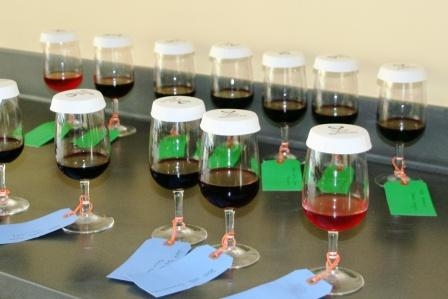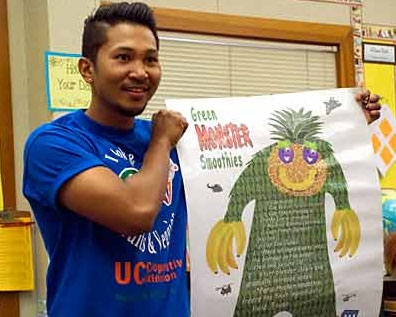UC Food and Agriculture Blogs
What are those flies coming out of the drain?
Drain flies, also called moth flies, are small flies that develop in decaying organic matter in sink or sewer drains. Their wings are covered with fine hairs, giving them a moth-like appearance. When many adults emerge at the same time, they can become a...

A drain fly
The fine art of spitting: Allowing underage students to taste alcohol
California's drinking age of 21 prohibits many undergraduate students from learning critical skills early in their academic careers — sensory skills that they will need when they move on to jobs in the multimillion-dollar winemaking, brewing, and food industries.
Not until students turn 21 can they taste the wine and beer they make and learn to assess its sensory quality. Learning the characteristics of a wide assortment of good (and not-so-good) wines and beers is an important component of winemaking and brewing. Having to wait until their junior or senior year to learn these skills is a disadvantage for these students.
Legislation (AB 1989) has been proposed by California Assemblyman Wesley Chesbro (D-North Coast) that will allow students, ages 18 to 21, enrolled in winemaking and brewery science programs to taste alcoholic beverages in qualified academic institutions. The students can taste, but not consume — which means they must learn the professional practice of spitting during the tasting process.
Professor Andrew Waterhouse, an enologist in the Department of Viticulture and Enology at UC Davis, notes that tasting is critical to the students' education.
“Winemakers taste wine daily during harvest to quickly make critical decisions as the winemaking is underway,” Waterhouse said. “Our students need to start learning this skill here, with our guidance. And, they also have to get over the embarrassment of spitting — after every taste.”
Chik Brenneman, the UC Davis winemaker, said that the bill, if passed, “will allow students to move on to the sensory program a lot sooner, before they've finished most of their winemaking classes. Earlier sensory training will help them when they go to work in the industry.”
Waterhouse said in an interview with NBC Bay Area, “If you don't have the experience of what wine tastes like as it's being made, then you're completely missing a critical skill, which you then have to learn on the job.”
If the legislation passes, it will benefit enology and brewing students at UC Davis, which is the only University of California campus to offer undergraduate degrees in viticulture and enology and in brewing science (an option within the food science major).
While parents of college students may worry that the bill will open the door to widespread drinking, Waterhouse and Brenneman both noted that the focus of the bill is so narrow that its impact will benefit a limited number of students, and that it's unlikely to lead to excessive drinking. They say that the over-21 students routinely spit what they're tasting in a standard industry manner, and that “drinking” in class is not a problem.
With passage of this bill, which is backed by the University of California, the state will join 12 other states that have allowed this educational exemption for students.
Read more:
- California legislative information on AB 1989
- NBC Bay Area: Reality check: Bill calls for underage tasting on college campuses, Feb. 27, 2014
- Bill by Wes Chesbro would allow underage beverage students to sip; PressDemocrat.com, Feb. 28, 2014
Tell Your Customers About Mulch
[From March 2014 issue of the Retail Nursery and Garden Center IPM News.] Anything used to cover the surface of the soil in a landscape or garden is called mulch. Most retail nurseries and garden centers sell a variety of mulch products in smaller...
What's the Problem with Neonicotinoids?
[From March 2014 issue of the Retail Nursery and Garden Center IPM News.] A massive killing of bumblebees in Oregon, concerns about impacts on honey bees, and tight new regulations imposed by the European Union have kept neonicotinoid insecticides in...
UC creates recipes for healthier diets
University of California Cooperative Extension nutrition educator Marc Sanchez brings the fearsome beast with him on school visits to classrooms in Merced and Stanislaus counties.
“Let me introduce to you the Green Monster,” Sanchez says to a classroom of second-graders at Yamato Colony Elementary School in Livingston. “Is anybody scared?”
“Noooo,” the kids roar in defiance of the beast.
The school visits are just one of the ways UC researchers, educators and cooperative extension representatives across the state are encouraging children and their families to eat healthier. They also are introducing them to fresh produce, doing cooking demonstrations and helping school districts prepare healthier meals.
About 17 percent of American children and adolescents are obese, according to the Centers for Disease Control and Prevention. During the last 30 years, obesity rates have more than doubled for children ages 6 to 11 and tripled for adolescents ages 12 to 19. It's an ominous statistic that could be improved if children ate more fruits and veggies.
Connecting schoolkids to farmers
UC's nutrition education programs try to promote better eating habits by connecting schools to local farms and farmers. Known as farm-to-school programs, students learn about where their food comes from and how it's grown — and in the process, learn to eat a balanced diet. Often, the children then become the conduit that brings healthier eating to the whole family.
“UC is on the forefront of these programs,” said Theresa Spezzano, UC Cooperative Extension director for Stanislaus and Merced counties and a nutrition, family and consumer science adviser. “The majority of the work is in some sort of school-based program.”
Nutrition education from UC reaches children, families and classrooms in nearly every part of the state.
Cooperative Extension, part of UC's Division of Agriculture and Natural Resources, runs two federal programs for low-income families in California — the Expanded Food and Nutrition Education Program and the CalFresh Nutrition Education Program. Together they reach more than 180,000 people.
Changing the corner store
At UCLA, public health professor Alex Ortega leads an effort to make more healthy food available in low-income urban areas by working with neighborhood convenience stores to replace junk food with fresh fruits and vegetables.
The project is based in East Los Angeles — a predominately Mexican-American community where diabetes and obesity rates are high. Four stores have agreed to restock their shelves and refrigerators. In return, storeowners are being trained in how to market fresh fruits and vegetables. There is also an outreach program that uses local high school students to educate nearby residents about healthy eating and what's available at the transformed markets.
“It's just one part of a very complex puzzle. We understand other things have to be going on, including promoting more physical activity,” said Ortega, director of the UCLA Center for Population Health and Health Disparities that is funded by the National Heart, Lung and Blood Institute. “Providing access to healthy food is significant part of the puzzle. If people don't have access and health education, you can't expect the community to be eating healthy.”
Ortega said data are being gathered on the effectiveness of the five-year project in East Los Angeles. But even if they don't find extensive shifts in behavior, “just getting people in the community thinking about eating healthier is a major step,” he said.
Education + access = healthy choices
Although there have been few long-term studies on the effectiveness of nutrition education programs, one small study of four schools in Sacramento and Stanislaus counties suggests that farm-to-school education and access to healthier food can help lower obesity rates among children.
The schools are taking part in a UC Davis and Cooperative Extension program called Shaping Healthy Choices, which includes an exercise component, along with nutrition education and access to more fresh produce.
That kind of multi-component program is “a promising model for how schools can play a role in promoting healthy food choices and reducing childhood obesity,” said Sheri Zidenberg-Cherr, co-director of the Center for Nutrition in Schools at UC Davis, who helped lead the study.
In Sanchez's experience, the best way to reach kids is to make eating healthy food a positive experience and one they are likely to remember.
“I can tell them, ‘eat this because it's better for you,' but they hear that all the time,” he said. “I want to do something that catches their eye. What's more appealing, calling it a Green Monster or a spinach drink?”
View a slide show below to experience Marc Sanchez' interaction with children as he teaches healthful eating:





